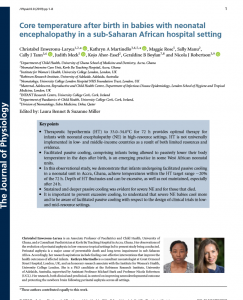
Abstract
Neonatal encephalopathy (NE) is a significant worldwide problem with the greatest burden in sub-Saharan Africa. Therapeutic hypothermia (HT), comprising the standard of care for infants with moderate-to-severe NE in settings with sophisticated intensive care, is not available to infants in many sub-Saharan African countries, including Ghana. We prospectively assessed the temperature response in relation to outcome in the 80 h after birth in a cohort of babies with NE undergoing ‘facilitated passive cooling’ at Korle Bu Teaching Hospital, Accra, Ghana.
We hypothesized that NE infants demonstrate passive cooling. Thirteen infants (69% male) 36 weeks with moderate-to-severe NE were enrolled. Ambient mean ± SD temperature was 28.3±0.7°C.Infant core temperature was 34.2±1.2°C over the first 24 h and 35.0±1.0°C over 80h. Nadir mean temperature occurred at 15h.Temperatures were within target range for HT with respect to 18±14% of measurements within the first 72h. Axillary temperature was 0.5±0.2°C below core.
Three infants died before discharge. Core temperature over 80h for surviving infants was 35.3±0.9°C and 33.96±0.7°C for those that died (P=0.043).Temperature profile negatively correlated with Thompson NE score on day 4 (r2 =0.66): infants with a Thompson score of 0–6 had higher temperatures than those with a score of 7–15 (P=0.021) and a score of 16+/deceased (P = 0.007). More severe NE was associated with lower core temperatures.
Passive cooling is a physiological response after hypoxia–ischaemia; however, the potential neuroprotective effect of facilitated passive cooling is unknown. An awareness of facilitated passive cooling in babies with NE is important for the design of clinical trials of neuroprotection in low and mid resource settings.